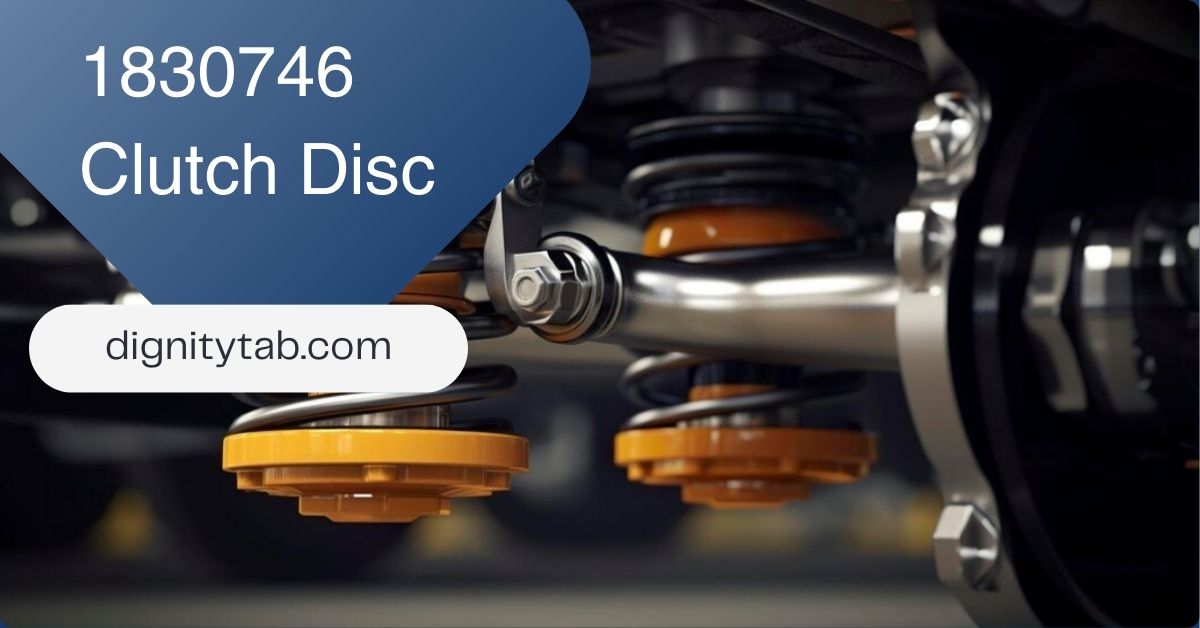The 1830746 clutch disc is a vital component in automotive systems, playing a key role in ensuring smooth gear transitions and optimal vehicle performance. This comprehensive guide will delve into every aspect of the 1830746 clutch disc, from its functionality and importance to its maintenance and troubleshooting. Whether you’re a car enthusiast, a mechanic, or simply looking to understand more about this crucial part, this article will provide you with all the information you need.
What is the 1830746 Clutch Disc?
The 1830746 clutch disc is an essential part of a vehicle’s clutch assembly. It’s designed to help engage and disengage the engine from the transmission, allowing smooth gear changes. The clutch disc operates by pressing against the flywheel and the pressure plate, which enables the vehicle to change gears seamlessly.
Key Features of the 1830746 Clutch Disc
- Material Composition: The disc is usually made from a combination of organic materials and friction linings. These materials are chosen for their durability and ability to handle the heat generated during operation.
- Size and Dimensions: The specific dimensions of the 1830746 clutch disc are designed to match the requirements of various vehicle models, ensuring a perfect fit.
- Performance: This disc is engineered to offer high performance, with excellent frictional properties and heat resistance.
How Does the 1830746 Clutch Disc Work?
Understanding how the 1830746 clutch disc works involves a basic grasp of clutch operation in a vehicle. The clutch disc is mounted on the transmission shaft and sits between the flywheel and the pressure plate. Here’s a simplified explanation of its function:
- Engagement: When you press the clutch pedal, the clutch disc is disengaged from the flywheel. This allows you to shift gears without grinding them.
- Disengagement: When the clutch pedal is released, the clutch disc re-engages with the flywheel, transferring power from the engine to the transmission.
This process ensures that the vehicle can change gears smoothly, providing better control and driving comfort.
Importance of the 1830746 Clutch Disc
The 1830746 clutch disc is crucial for several reasons:
- Smooth Gear Changes: It allows for smooth engagement and disengagement of the gears, which is essential for maintaining vehicle control and comfort.
- Preventing Gear Slippage: A well-functioning clutch disc prevents gear slippage, which can cause damage to the transmission and other components.
- Extending Vehicle Life: By ensuring that the gears engage properly, the clutch disc helps to extend the life of the vehicle’s transmission system.
Signs of a Failing 1830746 Clutch Disc
Over time, the 1830746 clutch disc can wear out or malfunction. Recognizing the signs of a failing clutch disc can help you address issues before they become serious problems. Common symptoms include:
- Slipping Clutch: If the engine revs increase without a corresponding increase in speed, it may indicate that the clutch disc is slipping.
- Difficulty Shifting Gears: Hard or rough gear changes can be a sign that the clutch disc is not engaging properly.
- Grinding Noise: A grinding noise when changing gears can indicate that the clutch disc is worn out or damaged.
- Vibration: Excessive vibration during acceleration can be a sign of a faulty clutch disc.
How to Inspect and Replace the 1830746 Clutch Disc
Regular inspection and timely replacement of the 1830746 clutch disc are essential for maintaining optimal vehicle performance. Here’s a step-by-step guide:
Inspecting the Clutch Disc
- Check for Slippage: Test the clutch for slippage by accelerating while in gear. If the engine revs higher than usual, the clutch disc may be worn.
- Listen for Noise: Pay attention to any unusual noises when engaging or disengaging the clutch.
- Inspect for Physical Damage: Look for visible signs of wear or damage on the clutch disc surface.
Replacing the Clutch Disc
- Lift the Vehicle: Use a car jack to lift the vehicle and secure it with jack stands.
- Remove the Transmission: Disconnect the transmission from the engine by removing the bolts and carefully sliding it out.
- Replace the Clutch Disc: Remove the old clutch disc and install the new 1830746 clutch disc in its place.
- Reassemble the Transmission: Reattach the transmission and ensure all bolts are securely fastened.
- Test Drive: After reassembly, take the vehicle for a test drive to ensure that the new clutch disc is functioning correctly.
Maintenance Tips for the 1830746 Clutch Disc
Proper maintenance can extend the life of your 1830746 clutch disc and ensure smooth operation. Here are some tips:
- Avoid Riding the Clutch: Keep your foot off the clutch pedal when not shifting gears to prevent unnecessary wear.
- Regular Inspections: Have your clutch system inspected regularly by a professional to catch potential issues early.
- Proper Driving Habits: Use proper driving techniques, such as fully engaging the clutch before shifting gears, to reduce wear.
Choosing the Right 1830746 Clutch Disc
When selecting a 1830746 clutch disc, consider the following factors:
- Compatibility: Ensure that the clutch disc is compatible with your vehicle’s make and model.
- Quality: Opt for high-quality clutch discs from reputable manufacturers to ensure reliability and performance.
- Price: While cost is important, don’t compromise on quality for the sake of a lower price.
Common Brands and Manufacturers
Several reputable brands manufacture the 1830746 clutch disc. Some well-known manufacturers include:
- Valeo
- Exedy
- LUK
- Sachs
Choosing a reputable brand ensures that you receive a high-quality product that meets OEM standards.
FAQs
What is the purpose of the 1830746 clutch disc?
The 1830746 clutch disc helps in engaging and disengaging the engine from the transmission, allowing smooth gear changes and optimal vehicle performance.
How can I tell if my clutch disc needs replacing?
Signs of a failing clutch disc include slipping, difficulty shifting gears, grinding noises, and vibrations during acceleration.
How often should I inspect my clutch disc?
It’s a good practice to have your clutch system inspected regularly, ideally during routine vehicle maintenance or if you notice any symptoms of a failing clutch.
Can I replace the clutch disc myself?
Replacing the clutch disc is a complex process that requires mechanical skills and tools. If you’re not experienced, it’s best to have a professional handle the replacement.
What should I look for when buying a replacement clutch disc?
Ensure that the replacement clutch disc is compatible with your vehicle’s make and model, opt for high-quality brands, and consider the price in relation to quality.
Conclusion
The 1830746 clutch disc is a critical component in maintaining the smooth operation of your vehicle’s transmission system. Understanding its function, recognizing signs of failure, and knowing how to properly inspect and replace it are essential for any vehicle owner. By following the guidelines provided in this article, you can ensure that your clutch system remains in top condition, providing reliable and efficient performance.
For further assistance or if you have specific questions about the 1830746 clutch disc, don’t hesitate to consult a professional mechanic or refer to your vehicle’s service manual.



